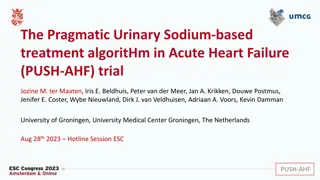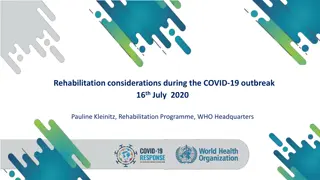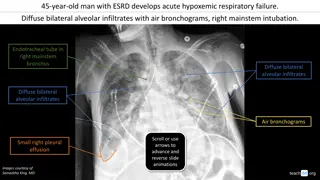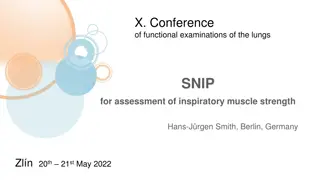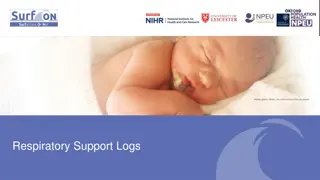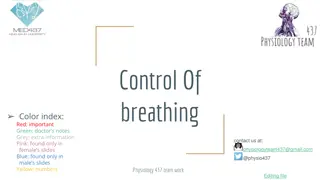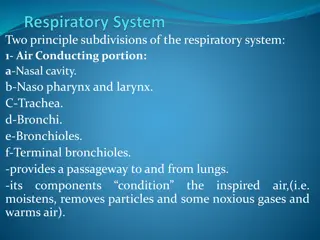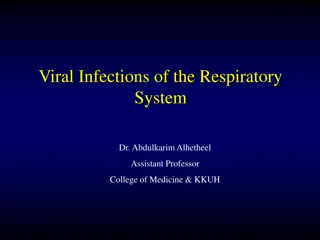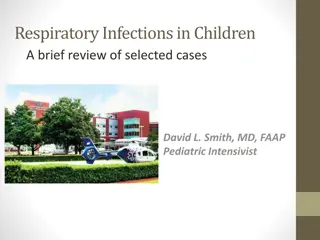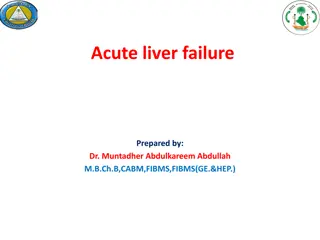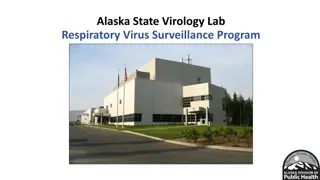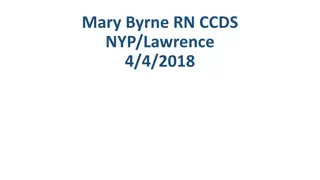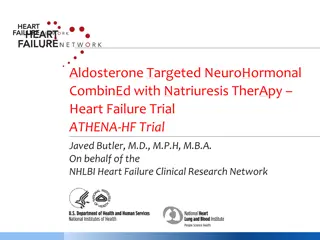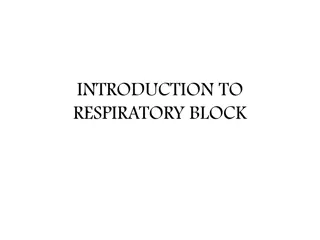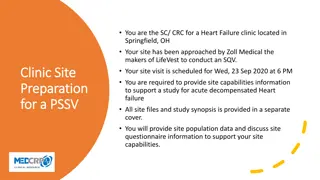NIV in Acute Respiratory Failure: Overview and Benefits
The use of Non-Invasive Ventilation (NIV) in acute respiratory failure including indications, initiation, predictors of failure, benefits, and complications. Learn the brief history, selected conditions for NIV, and why it is essential in decreasing work of breathing and avoiding intubation, leading to reduced ICU stay and costs.
Download Presentation

Please find below an Image/Link to download the presentation.
The content on the website is provided AS IS for your information and personal use only. It may not be sold, licensed, or shared on other websites without obtaining consent from the author.If you encounter any issues during the download, it is possible that the publisher has removed the file from their server.
You are allowed to download the files provided on this website for personal or commercial use, subject to the condition that they are used lawfully. All files are the property of their respective owners.
The content on the website is provided AS IS for your information and personal use only. It may not be sold, licensed, or shared on other websites without obtaining consent from the author.
E N D
Presentation Transcript
NIV IN ED M Anto ED prov fellow MVH 2 Feb 2017
What we will cover today Brief history Pt selection - Indications - Contraindications Initiation Predictors of failure Benefits Complications Summary
What we wont cover today HFNP vent for paeds
NIV Mechanical respiratory support without the need for endotracheal intubation through an interface Continuous positive pressure ventilation Bilevel positive airway support Acute and chronic resp failure
Brief history Reports available from mid 1700s of a bellows-type device Negative pressure tank device (Dalziel 1832) Iron lung (Drinker 1928, Emerson 1932) Positive pressure devices 1952 as neg pressure devices were: - Large - Difficult to access pt for cares - No PEEP - Leakage - Tank shock blood pooled in extremities
Acute respiratory failure Acute hypoxia requiring supplemental FiO2to maintain a SpO2 92 percent AND/OR Acute hypercarbia with a PaCO2>50 mmHg (with an arterial pH usually <7.35) In practice, clinicians often intervene based upon oxygen saturation and degree of respiratory distress (eg, severe tachypnoea, retractions), without obtaining blood gases initially
Why do we do it? Decrease work of breathing Maintain patency throughout the respiratory tract - upper airways to the smaller lower airways - facilitate expiratory flow and reduce obstructive apnea Recruit alveoli - increase functional residual capacity (FRC) - decreased ventilation-perfusion (V-Q) mismatch Reduces preload Avoids intubation Decr ICU LOS/complications Decr cost
What conditions can NIV be used in? COPD with hypercapnoeic acidosis - pCO2 >45 - pH<7.30 Cardiogenic pulmonary oedema Acute hypoxaemic respiratory failure - ?Pneumonia - ?asthma Post-extubation resp support Chest trauma despite regional wall anaesthesia OSA Delayed sequence intubation Do not intubate status
COPD (eMedicine) COPD is the most suitable condition for NIV Most effective in patients with mod-sev disease Hypercapnoeic respiratory acidosis may define the best responders (pH 7.20-7.30) Also effective in patients with a pH of 7.35-7.30, but no added benefit is appreciated if the pH is greater than 7.35 The lowest threshold of effectiveness is unknown, but success has been achieved with pH values as low as 7.10 Obtunded COPD patients can be treated, but the success rate is lower Improvement after 1-2hr trial may predict success
APO (eMedicine) NIV is suited for patients with cardiogenic pulmonary edema CPAP and BiPAP modalities both are effective, with CPAP possibly being more effective Greatest benefits are relief of symptoms and dyspnoea Decr in intubation and mortality rates is not a universal experience Patients with hypercapnoeic respiratory acidosis may derive the greatest benefit from NIV Adjust to standard therapy, including diuresis Benefit may be seen within 2hrs of support
Absolute contraindications Coma Cardiac arrest Respiratory arrest Any condition requiring immediate intubation
Other contraindications Cardiac instability GI bleeding Inability to protect airway Status epilepticus Severe decr GCS (except maybe hypercapnoeic encephalopathy) Facial injuries/burns Upper airway obstruction e.g. neckmass, anaphylaxis Lack of trained staff
Pt selection Cooperative Dyspnoea (mod-sev) Tachypnoea RR >25 Incr WOB Hypercapnoeic resp acidosis Hypoxaemic
Modes of ventilation BiPAP pressure (preferred) - Assist mode or pressure support ventilation - With or without apnoea back-up - Pressure control ventilation (less used in ED) BiPAP volume (not used much in ED) CPAP - Not a ventilatory mode
Goals of initial therapy Start with IPAP 10 + EPAP 5 (equivalent to PS 5 + PEEP 5) (IPAP = PS + PEEP) (EPAP = PEEP) TV = 6ml/kg IBW RR <25 [Back-up rate 12-16] SpO2 >90% Aim for improvement in 2hrs
Titration If SpO2 <90% - then incr EPAP/PEEP (max 15cmH2O) If RR >25, or incr/persistant acidosis/hypercapnoea - then incr IPAP (max 25cm) - to incr VT by 1ml/kg IBW q15min (max 8ml/kg)
Monitoring/weaning ABG RR, SpO2, WOB, HR Give breaks every 30-90min Decr IPAP/EPAP once stable/improving
Success Decr pCO2 Improve pO2 Improve pH Decr RR Decr WOB Decr HR
Failure No improvement Deterioration Decr GCS Hypotension MI or arrhythmias Pt intolerance of treatment
Complications Gastric distension, vomiting, aspiration Drying of secretions, mucous plugging, nasal congestion, eye irritation Hypotension PTx Anxiety/claustrophobia Facial/nasal skin breakdown
Summary Good for COPD + APO Consider for other indications + no CI Start at standard settings, and titrate Monitor and wean/escalate as required Consider sedation
References Uptodate eMedicine Guide for NIV using the draeger oxylog 3000plus (LITFL, G Douros)



